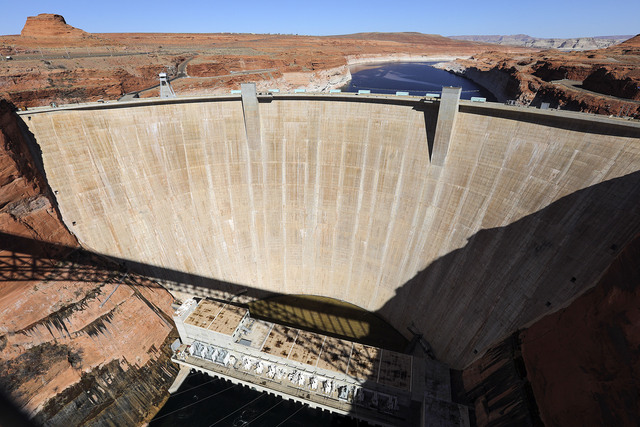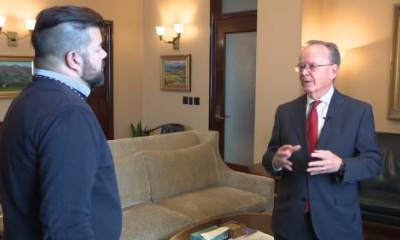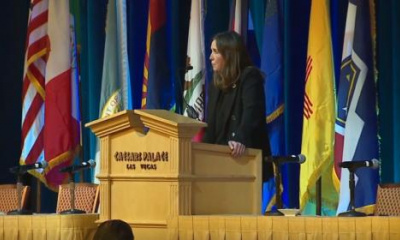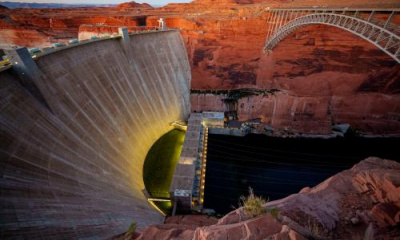Lake Powell and Lake Mead’s declining water levels force basin states to confront old rules in a new reality
The Colorado River is managed like a joint bank account — seven states have equal shares of two basins, and not a single drop of water is overlooked. Lake Powell in Utah and Lake Mead in Nevada manage the fortune; when drought hits, and the budget is low, the stress of being down on funds is shared among account partners.
One of the first lessons I learned when trying to understand the endless issues surrounding the river was to put them into one of three categories: People, policy and ecosystem.
When the Colorado River Compact was established in 1922, it allocated 7.5 million acre-feet of water per year, or 75 million acre-feet over 10 years, to each of the two basins. However, the river’s strain from population growth in certain areas, agricultural demands and the impacts of climate change have decreased the flow significantly, often delivering less than the initially intended amount.
“We know that the Colorado River is a very volatile river, and you can’t count on those flows being available every year. That’s why we built Lake Powell,” Anne Castle, U.S. commissioner for the Upper Colorado River Commission, said. “It is kind of an article of faith in the upper basin that Lake Powell is what buffers us against the delivery obligation and non-depletion obligation.”
In 1956, the Colorado River Storage Project was enacted to ensure well-managed water storage for the upper basin states (Colorado, New Mexico, Utah, and Wyoming) via the Glen Canyon dam. The dam is also the largest facility on the river designed to ensure water release requirements for the lower basin states (Arizona, California, Colorado, and Nevada) are met.
Anne Castle, U.S. commissioner for the Upper Colorado River Commission, takes in the scenery on a Returning Rapids trip in Cataract Canyon on the Colorado River on Saturday, Sept. 21, 2024. | Kristin Murphy, Deseret News
“The idea is, you’ve got this big bucket that’s going to be there to meet your 7.5 over 10 (years), and the upper basin can develop its full compact obligation,” Castle added, but “the upper basin has never developed its full compact allocation of 7.5 million acre-feet, probably because there’s not enough water to do that in the upper basin.”
According to the Glen Canyon Institute, the reservoir has lost more than 35 million acre-feet of water from evaporation and bank storage since the dam’s completion, adding up to nearly $9 billion in lost value.
Lake Powell is currently about 37% full and hasn’t been at a total full pool since it was filled to completion in 1980.
“We need to operate things differently. And I think there’s a parallel, or there could be that we all know that climate change has totally altered the foundations that we thought we were relying on, and now we need to have the laws catch up with that,” Castle said. “They’re not there yet, in my opinion, but they could be.”
The Glen Canyon Dam is pictured in Page, Ariz., on Sunday, March 28, 2021. | Kristin Murphy, Deseret News
Basin states clash on new Colorado River plan
In March, the upper and lower basin states each submitted new river management plans to the federal government; the current guidelines, enacted in 2007 and revised in 2022, will expire in 2026. These guidelines control how much water passes between Lake Powell and Lake Mead, and another part of the guidelines controls how much water is reduced in the basin.
“We can no longer accept the status quo of Colorado River operations,” Becky Mitchell, Colorado’s commissioner to the Upper Colorado River Commission, said in a press release after the upper basin’s plan was published.
“If we want to protect the system and ensure certainty for the 40 million people who rely on this water source, then we need to address the existing imbalance between supply and demand. That means using the best available science to work within reality and the actual conditions of Lake Powell and Lake Mead. We must plan for the river we have — not the river we dream for,” she added.
The lower basin’s plan emphasized the struggle to agree between the two basins.
“Although there is agreement among the basin states regarding the need to provide for operations of Lake Powell and Lake Mead under a wide range of potential future system conditions due to a changing climate, at this point the seven basin states have been unable to agree on a consensus alternative.”
States are struggling so much to agree on just the water supply issues and figure out how to cut back usage to address climate change challenges that there’s little room left to tackle other concerns.

Jack Schmidt, USU’s Janet Quinney Lawson Colorado River Studies chair and Center for Colorado River Studies director, holds a pinecone he suspects was carried down river during a spring flash flood in Millcreek Canyon and deposited below Gypsum Canyon rapid, during a six day Colorado River trip with the Returning Rapids Project in Cataract Canyon on Saturday, Sept. 21, 2024. Schmidt said, “Driftwood piles are one attribute of the river of the past (of the pre-dam era.) This carbon fueled much of the aquatic ecosystem.” | Kristin Murphy, Deseret News
“I would argue that from the grand scale of just straight physical processes, engineering and water use, it doesn’t matter who cuts, right,” Jack Schmidt, the Janet Quinney Lawson Chair in Colorado River Studies at USU and the director of the Center for Colorado River Studies, said.
“You’ve got one giant bathtub, then you have a national park, and then you have another giant bathtub, and nobody uses water in the whole area, so it doesn’t matter where,” he said. “But we’re a nation of laws, and we’re probably not going to change those distributions in any significant way in terms of how the reservoirs are operated in the next two years.”
When it comes to water use, Colorado River Commissioner of Utah Gene Shawcroft told the Deseret News that all states are relatively cognizant of water use and conservation. From his perspective, there has been a lot of great and creative work done amongst the seven basin states to ensure the best outcome for the Colorado River.
“We’re in weekly negotiations, if not more frequently than that, with the upper and lower division states to try to come up with a new operating plan that would replace the ‘07 guidelines because, frankly, they weren’t robust enough to deal with (the) poor hydrology that we’ve had,” he added.
“But when Mother Nature throws us the curveball she has the last 20 years, I just don’t know,“ Shawcroft said. “The issues are extremely complex, and so progress from someone on the outside looking in could say that we’re not making enough progress, and there are times I would agree with that, but we are still talking, we’re still working with (the Bureau of) Reclamation. We recognize that we’ve got to come up with something that works.”
A draft of the 2026 guidelines is expected to be released in December.











